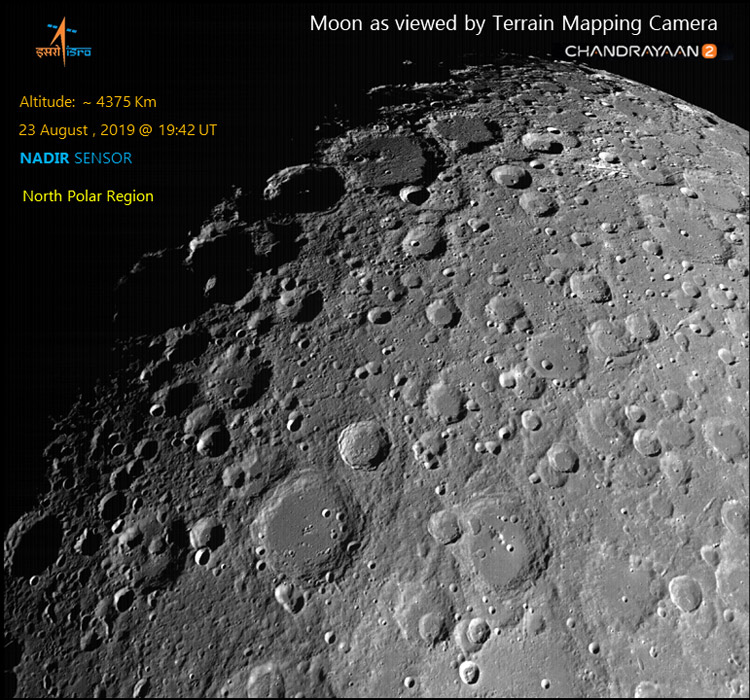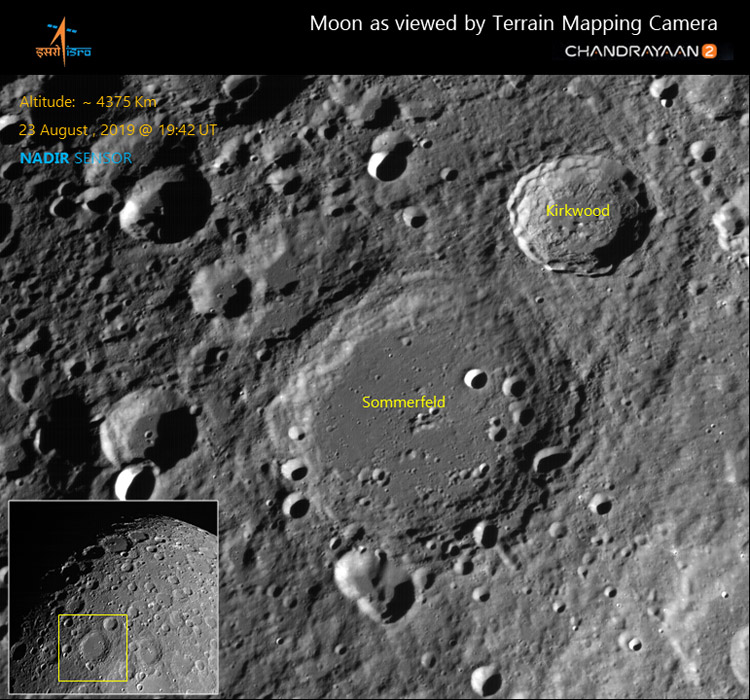INDIAN ARMED FORCES CHIEFS ON
OUR RELENTLESS AND FOCUSED PUBLISHING EFFORTS

SP Guide Publications puts forth a well compiled articulation of issues, pursuits and accomplishments of the Indian Army, over the years

I am confident that SP Guide Publications would continue to inform, inspire and influence.

My compliments to SP Guide Publications for informative and credible reportage on contemporary aerospace issues over the past six decades.
- Prime Minister witnesses 'Bharat Shakti' – a Tri-Services Firing and Manoeuvre Exercise in Pokhran, Rajasthan
- Interim Defence Budget 2024-25 — An Analysis
- Union Defence budget 2024
- Prime Minister Modi Commemorates Indian Navy Day in a Grand Ceremony
- Prime Minister Modi Flies in the LCA Tejas
- New Chapter in India-Italy Defence Ties
- Airpower beyond Boundaries
Lander Vikram separates successfully from Chandrayaan-2 Orbiter
Inching closer to maiden discoveries, Chandrayaan-2 spacecraft is scheduled to have a soft landing on Moon's South Polar Region through its lander Vikram on September 7.
With the successful separation of the lander, Vikram, India's second Moon mission, Chandrayaan-2, is one more step closer to exploring the never before explored the region of the Moon. On Monday, September 2, 2019, at 1315 hrs IST, the Vikram Lander carrying the Pragyaan rover, separated from the Orbiter of Chandrayaan-2 as was scheduled.
#ISRO
— ISRO (@isro) September 2, 2019
Vikram Lander Successfully separates from #Chandrayaan2 Orbiter today (September 02, 2019) at 1315 hrs IST.
For details please visit https://t.co/mSgp79R8YP pic.twitter.com/jP7kIwuZxH
Launched on the three-stage GSLV-Mk-III-M1, Chandrayaan-2 carried an Orbiter, a Lander (named Vikram) and a Rover (named Pragyaan).
A few hours after Vikram soft lands on the lunar surface, the Rover Pragyaan is scheduled to roll down from Vikram and perform in situ exploration of the surrounding lunar surface. The instruments on the Rover will analyze the surface and send back data. The Rover can only communicate with the Lander.
Presently, Vikram is located in an orbit of 119 km x 127 km around the Moon while the Orbiter is in the continuous process of orbiting the Moon in its existing orbit. The Orbiter has the mission life of a year, during which it shall continue its trajectory around the Moon. The Orbiter will be observing the lunar surface and relay communication between Earth and the Vikram Lander.
While Vikram will now perform a series of complex braking maneuvers to soft land in the South Polar Region of the Moon on September 7, 2019. A few hours after Vikram soft lands on the lunar surface, the Rover Pragyaan is scheduled to roll down from Vikram and perform in situ exploration of the surrounding lunar surface. The instruments on the Rover will analyze the surface and send back data. The Rover can only communicate with the Lander. The Orbiter will move around the Moon for remote sensing, while the various science payloads that were attached with the spacecraft will gather information on lunar topography, mineralogy, elemental abundance, lunar exosphere and signatures of hydroxyl and water-ice.
The Orbiter has the mission life of a year, during which it shall continue its trajectory around the Moon. The Orbiter will be observing the lunar surface and relay communication between Earth and the Vikram Lander.
This would be the first space mission of the world to conduct a soft landing on the Lunar South Pole. The surface area in this region of the Moon (that remains in shadow) is much larger compared to that in the North Polar Region. Indian Space Research Organisation (ISRO) had also informed earlier that the lunar South Pole region has craters that are cold traps and contain a fossil record of the early Solar System. Moon's South Polar Region is also the area where traces of water were detected earlier during India's first Moon mission, Chandrayaan-1.
The Mission Operations Complex (MOX) at ISRO Telemetry, Tracking and Command Network (ISTRAC) in Bengaluru is monitoring the health of the Orbiter as well as the Lander, with support from Indian Deep Space Network (IDSN) antennas at Bylalu, near Bengaluru. As of now, ISRO reported all the systems of Chandrayaan-2 Orbiter and the Lander to be healthy.
On Sunday, September 1, 2019, at 1821 hrs IST, the final and fifth Lunar bound orbit maneuver was performed successfully for Chandrayaan-2 spacecraft using the onboard propulsion system. The duration of the maneuver was 52 seconds as reported by ISRO and the orbit achieved was 119 km x 127 km.
This would be the first space mission of the world to conduct a soft landing on the Lunar South Pole.
The previous four lunar orbit maneuvers were conducted after the Lunar Orbit Insertion (LOI) of Chandrayaan-2 was successfully completed on August 20, 2019. The insertion was followed by a successful second lunar orbit maneuver performed on August 21, the third on August 28, the fourth lunar bound orbit maneuver on August 30, and the final maneuver on September 1.
Taken at a height of about 2650 km from the lunar surface, the first Moon image was captured by Chandrayaan-2 Vikram Lander On August 21. Mare Orientale basin and Apollo craters were identified in the picture.

Lunar Surface images
On August 26, 2019, ISRO released images of the lunar surface as captured by the Terrain Mapping Camera 2 (TMC-2) of Chandrayaan-2 on 23rd August 2019.
#ISRO
— ISRO (@isro) August 26, 2019
Lunar surface imaged by Terrain Mapping Camera-2(TMC-2) of #Chandrayaan2 on August 23 at an altitude of about 4375 km showing craters such as Jackson, Mach, Korolev and Mitra (In the name of Prof. Sisir Kumar Mitra)
For more images please visit https://t.co/ElNS4qIBvh pic.twitter.com/T31bFh102v
The TMC-2 also captured the Lunar North Polar region on the same date from the same altitude. The images captured also showed the impact craters such as Plaskett (109km), Rozhdestvenskiy (177km) and Hermite (104 km ; one of the coldest spots in the solar system ~ 25K). Impact craters such as Sommerfeld located in the far side northern latitudes of the Moon and Kirkwood located North east to Sommerfeld was also captured.


The next maneuver of Vikram is scheduled for Tuesday, September 3, 2019 between 0845-0945 hrs IST.
Propelled on July 22, this mission marks India's first attempt to land on the lunar soil. As of now, only Russia, USA, and China have been successful in achieving soft-landing on the Moon. If successful, India would be the fourth country in the list.
The mission aims to help gain a better understanding of the origin and evolution of the Moon by conducting detailed topographical studies, comprehensive mineralogical analyses, and a host of other experiments on the lunar surface.
The tentative plan for future operations after Vikram's separation, as revealed by ISRO, is as follows:
| Date | Time (IST) | Orbit around Moon | |
|---|---|---|---|
| Deorbit #1 | September 03, 2019 | 09:00 – 10:00 | 109 km x 120 km |
| Deorbit #2 | September 04, 2019 | 03:00 – 04:00 | 36 km x 110 km |
| Powered Descent | September 07, 2019 | ||
| Vikram Touch Down | September 07, 2019 | 01:30 – 02:30 |





